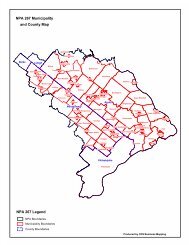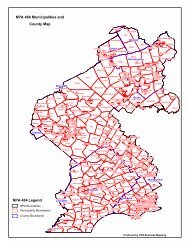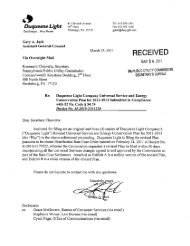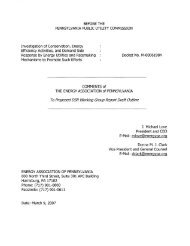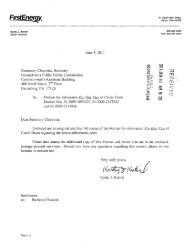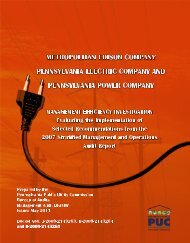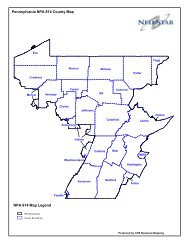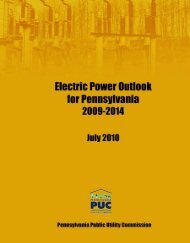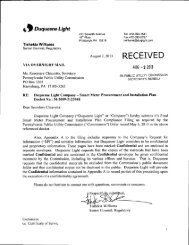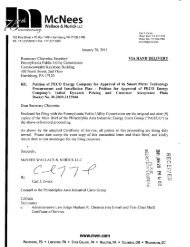UGI Energy Services, Inc. - Pennsylvania Public Utility Commission
UGI Energy Services, Inc. - Pennsylvania Public Utility Commission
UGI Energy Services, Inc. - Pennsylvania Public Utility Commission
- No tags were found...
You also want an ePaper? Increase the reach of your titles
YUMPU automatically turns print PDFs into web optimized ePapers that Google loves.
($) fi; A S .M A K K fOWCkMAKK<strong>UGI</strong> <strong>Energy</strong> <strong>Services</strong>, <strong>Inc</strong>.November 3, 2011VIA ELECTRONIC FILING AND FEDERAL EXPRESSRosemary Chiavetta, Secretary<strong>Pennsylvania</strong> <strong>Public</strong> <strong>Utility</strong> <strong>Commission</strong>Commonwealth Keystone Building400 North StreetHarrisburg, PA 17120Re: Investigation of <strong>Pennsylvania</strong>'s Retail Electricity Market: RecommendedDirectives on Upcoming Default Service Plans; Docket No. 1-2011-2237952Dear Secretary Chiavetta:Enclosed please find the original plus five (5) copies of the comments of <strong>UGI</strong> <strong>Energy</strong><strong>Services</strong>.. <strong>Inc</strong>. to the <strong>Commission</strong>'s Tentative Order issued October 14. 2011 in the abovecaptionedproceeding. Should you have any questions concerning this submission, please feelfree to contact me at (610)-992-3750.^'- . C=3\~> I -—o —rorn _ O,Very truly yours. ^^Melanie J. ElatiehCounsel for <strong>UGI</strong> <strong>Energy</strong> <strong>Services</strong>. <strong>Inc</strong>.mroCc: Office of Competitive Market Oversight Retail Markets Investigation (via e-mail at ra-RMI@state.pa.us)EnclosureI Meridian Boulevard Suite 2C0! I Wyomissing, PA 19610 610/373.7999 800/427.8545 Fax 6 i 0/374.4288 www. ugienergyservices.com
~-COMMONWEALTH OF PENNSYLVANIA ^' h'O 1 / 'Z" ^BEFORE THE PENNSYLVANIA PUBLIC UTILITY COMMISSION' 2li ,'>r--r.',- 1Re: Investigation of <strong>Pennsylvania</strong>'sRetail Electricity Market:Recommended Directives on UpcomingDefault Service PlansDocket No. 1-2011-2237952^ tCOMMENTS OF <strong>UGI</strong> ENERGY SERVICES, INC.I. Introduction<strong>UGI</strong> <strong>Energy</strong> <strong>Services</strong>, <strong>Inc</strong>. d/b/a <strong>UGI</strong> <strong>Energy</strong>Link ("<strong>UGI</strong>ES") submits these comments inresponse to the <strong>Pennsylvania</strong> <strong>Public</strong> <strong>Utility</strong> <strong>Commission</strong>'s ("<strong>Commission</strong>'s" or "PUC's")Tentative Order issued October 14, 2011 ("October 14th Tentative Order") in the abovereferencedproceeding. 1As background, <strong>UGI</strong>ES is a <strong>Pennsylvania</strong>-based company 2and licensed natural gas andelectric generation supplier that has provided electric generation and natural gas supply servicetosmall, medium and large commercial and industrial customers across the Commonwealthsince the inception of retail competition in <strong>Pennsylvania</strong>. More recently, <strong>UGI</strong>ES has begunproviding natural gas supply service to residential customers in <strong>Pennsylvania</strong> in certain naturalgas distribution company service territories and is contemplating expansion of its residentialmarketing efforts. <strong>UGI</strong>ES' retail commodity marketing activities extend beyond <strong>Pennsylvania</strong>'sborders into the Mid-Atlantic region and New York. As an electric supplier, <strong>UGI</strong>ES sells tocustomers behind 19 electric distribution companies in <strong>Pennsylvania</strong>, New Jersey, Delaware,Maryland, the District of Columbia and New York. On the gas side, <strong>UGI</strong>ES serves customer'This is the first set of comments submitted by <strong>UGI</strong>ES in this Investigation proceeding.~ <strong>UGI</strong>ES currently has over 150 employees and maintains a central office in Wyomissing, <strong>Pennsylvania</strong>, withregional offices in the following: Wilkes-Barre <strong>Pennsylvania</strong>, York, <strong>Pennsylvania</strong>, Port Allegany, <strong>Pennsylvania</strong>,Pittsburgh, <strong>Pennsylvania</strong>, Baltimore, Maryland, Moorestown, New Jersey, Albany, New York, Rochester, NewYork and Hudson, Ohio.
accounts behind 33 local distribution companies in <strong>Pennsylvania</strong>, New Jersey, Delaware,Maryland, the District of Columbia, New York, Virginia, West Virginia and North Carolina.<strong>UGI</strong>ES commends the <strong>Commission</strong> for undertaking the initiative through thisInvestigation proceeding to examine the structure of <strong>Pennsylvania</strong>'s retail electricity market andto explore ways to enhance competition and customer choice so that consumers in thisCommonwealth may continue to realize the benefits of competitive retail markets. Since thepassage of the Electricity Generation Customer Choice and Competition Act, <strong>Pennsylvania</strong> hasserved as a leader in electricity policy and the <strong>Commission</strong> should be applauded for successfullytransitioning the Commonwealth fromthe generation rate cap period to the well functioning, andin some cases highly competitive, marketplace that exists today. Generation rate caps have onlyrecently expired in the major EDC service territories in 2009 and 2010, and yet <strong>Pennsylvania</strong>'sretail electricity market is steadily maturing as measured by a growing number of customersshopping, the increased number of EGSs actively marketing to consumers and the expandingvariety of innovative and value-added product offerings being made available to consumers.Nevertheless, we agree with the <strong>Commission</strong> that improvements can and should be madeto the existing retail market structures to complete the transition to a truly competitive market.Through this proceeding, the <strong>Commission</strong> is taking a crucial next step in leading <strong>Pennsylvania</strong>'sretail electricity marketplace into achieving its full potential. As this proceeding goes forward,however, <strong>UGI</strong>ES recommends that the <strong>Commission</strong> preserve best practices and avoid creatingnew market barriers through administrative design that could negatively impact the future of<strong>Pennsylvania</strong>'s electric retail market.
II.Comments on the Recommendations in the October 14th Tentative OrderA. Hourly-Priced Default Service for Medium C&IIn the October 14th Tentative Order, the <strong>Commission</strong> recommended that EDCscontemplate in their next default service plans expanding the hourly-priced default servicecurrently available to large commercial and industrial customers ("C&I customers") to mediumsizedC&I customers, generally those customers with demand greater than 100 kW. <strong>UGI</strong>ES fullysupports the <strong>Commission</strong>'s recommendation to expand hourly-priced default service to mediumsizedC&I customers. As the <strong>Commission</strong> recognized in the October 14th Tentative Order,shopping among medium C&I customers is already significant. <strong>UGI</strong>ES believes the robustshopping levels are largely attributable to the sophisticated nature of these customers as well asthe significant number of EGSs competing for their business. Not only do EGSs compete toobtain these customers on price, but EGSs compete by offering a wide variety of innovative andvalue-added products.Although competition and choice are active among C&I customers above 100 kW, thecurrent structure of default service for these customers, which is based on a mixture of spotmarket and short-term fixed prices, impedes the ability of these customers to realize the fullbenefits of the market because it allows default service to directly compete with EGS productofferings on an uneven playing field. EDCs have an inherent advantage over EGSs in providingthe fixed-price default service because they can recover such costs from ratepayers while EGSsbear the risk of procuring the fixed-price product for customers. Moreover, linking medium C&Icustomers to real-time price signals will enhance their incentive and ability to shop for andaffirmatively choose an EGS product offering. <strong>UGI</strong>ES believes that structuring default servicefor this customer segment as an hourly-priced default service will appropriately change the roleof default service for these customers from an administrative barrier to competition to an3
appropriate backstop for choice and undoubtedly serve to bolster customer shopping and suppliercompetition among medium-sized C&I customers.B. Opt-In Retail AuctionsIn the <strong>Commission</strong>'s October 14th Tentative Order, the <strong>Commission</strong> recommended thatEDCs incorporate an opt-in auction program in their next default service plans.The<strong>Commission</strong> expressed the view that opt-in auctions represent "a creative marketing programthat can help increase customer awareness for shopping opportunities, provide customers withdirect benefits via savings and enrollment cash receipts, and instill peace of mind for customersthrough potential standard offer requirements." The <strong>Commission</strong> did not propose a specificformat for opt-in auctions in the Tentative Order but recommended that the EDCs use as astarting point the fonnat being discussed by a stakeholder sub-group in this Investigationproceeding. 3<strong>UGI</strong>ES appreciates the <strong>Commission</strong>'s willingness to examine creative solutions to breakthrough the customer inertia currently plaguing residential and small business customers in someEDC service territories. <strong>UGI</strong>ES questions, however, whether the implementation of a retail optinauction is premature at this time. The governing principle of <strong>Pennsylvania</strong>'s retail electricitymarket is full and self-determining customer choice. Because <strong>Pennsylvania</strong> has held fast to thisfundamental feature, <strong>Pennsylvania</strong> consumers are able to proactively shop for and affirmativelychoose a supplier. Empowering consumers to choose their supplier, in turn, pushes EGSs to viefor market share by competing with one another on price, non-pricing terms and product3Any representation to the <strong>Commission</strong> that the high-level principles being discussed in the stakeholder sub-grouphave reached consensus approval by sub-group members or have been developed on a consensus basis among subgroupmembers is inaccurate. The high level principles were initially drafted to help guide the design of any opt-inauction proposal, if one is to be implemented. Significant concerns have been expressed by sub-group membersregarding the concepts and details proposed, which are being robustly discussed in the sub-group meetings. It is notclear whether consensus can or will ever be achieved.
offerings. Although a retail opt-in auction may appear to respect choice by giving customers theability to "opt-in" to the auction, customers that opt to participate in this program will beresponding to an administratively-designed and marketed product offering and will be randomlyassigned to the winning EGS bidder without playing an active role in selecting the specific EGSthat provides their commodity service. Rate caps have only recently expired in the major EDCservice territories, and residential and small business customers are still adjusting from a longtermperiod marked by stagnant rates and limited product offerings to the complex marketplacewhere an array of choices are available to them. As we move away from the rate cap period,introducing administrative solutions to bolster customer choice may interfere with the naturalprogression of customer shopping over the long-term as customers are becoming increasinglymore aware of and comfortable with the market.Although a retail opt-in auction may potentially serve to boost customer shopping in thenear term, it also has the potential to create the same or additional barriers to market-entry as theEDC-provided default service.It has not been discussed whether this proposal wouldunintentionally result in a return to the same "status quo bias" currently plaguing residential andsmall business customers on default service. In fact, it is highly plausible that customers blindlyassigned to an EGS through the opt-in auction process will simply "stick" to the EGS to whichthey were blindly assigned — much like they stick to the EDC default service product now.Would these customers expect to be transferred back to default service after the auction periodexpires?Would customers be informed that upon the expiration of the auction period thecustomer would have to affirmatively switch back to the utility's regulated default serviceproduct or to another supplier if the customer is no longer satisfied with the EGSs service?Given that these programs do not regulate the price or non-pricing terms of an EGS in the years
eyond the auction period, customers who stick may feel they did not fully realize the benefit ofthe bargain they thought they were getting when they opted in.In addition, standardizing product offerings runs the risk of making consumers believethat choice is based on price competition alone, which is hardly the case in today's marketplace.Today, in addition to competing on price, suppliers compete on non-pricing terms (and anyonewith a cell phone plan understands the significance of non-pricing tenns) - such as, for example,structuring offerings to small commercial customers as full requirements, swing or variableproducts to help these customers' energy bills meet their budgeting needs, or waiving earlytermination fees for residential customers who switch back to default service prior to theexpiration of the fixed price offering so that customers may feel safe to leave at any point if theyare not satisfied with their choice. Suppliers also compete by offering a variety of value-addedservices that a customer may find more beneficial than simply obtaining a certain level of pricediscount - for example, a customer may select a green product or an HVAC service offering.Customers may believe that making a selection based on non-pricing terms or other value-addedproducts may add more value to their business' or residence's needs over a standard pricediscount off the price to compare. Standardizing the product offering runs the risk of creatingunrealistic consumer expectations or even customer confusion as customers may begin to expectall EGSs to offer a "standardized" product that resembles that which is offered in the retailauction.Furthennore, having the EDC in the role of conducting the auction may serve tocomplicate what should be a simple message of choice, as customers who participate in theauction may come to the wrong understanding that their decision to switch from their local utilityis only safe or beneficial when it is made as part of a utility-sponsored and administered auction
program. In addition, having the EDC advertise and run the auctions will likely disadvantage themarketers that have already invested in marketing resources and programs (to distinguishthemselves from the EDC default service product offering as well as the product offerings ofcompeting EGSs) by attracting new entrants that can short-cut the customer acquisition processwith a new set of rules.For the reasons described above, the retail opt-in auction may potentially serve as anadministrative method for picking winners and losers in this market segment (as opposed to themarket doing the picking), which could have the consequence of narrowing the pool ofcompeting suppliers and product offerings over time and thus reducing the benefits ofcompetition to consumers over the long-term. With that said, <strong>UGI</strong>ES recognizes that it is one ofthe EGSs that could possibly stand to gain from the implementation of a retail opt-in auction.From an EGS' perspective, this proposal presents a potentially cost-effective and relatively easyway to gain customers and market share through a price competitive initial offering. As afifteen-year participant in <strong>Pennsylvania</strong>'s retail marketplace, however, <strong>UGI</strong>ES takes greatinterest in the stable and sustaining development of <strong>Pennsylvania</strong>'s electric retail market and iswary of good-sounding ideas that may bring short-term benefits to a few but have unintendedlasting consequences for the market.<strong>UGI</strong>ES believes that the optimal next steps for overcoming customer inertia in theresidential and small business customer segment is to work toward improving the informationflow to consumers and addressing the EDC operational frictions that currently serve as market
impediments today 4As stated above, rate caps have only recently expired in the major EDCservice territories, and residential and small business customers are still adjusting from a longtermperiod marked by stagnant rates and limited product offerings to the complex marketplacewhere an array of choices are available to them. One way to enhance the ability of thesecustomers to shop for and affirmatively choose an EGS product that best suits their power usageneeds is to improve the information made available to consumers. The development of the<strong>Commission</strong>'s PA Power Switch website is a very positive step toward empowering choice asare the other customer education initiatives being discussed in this Investigation proceeding (e.g.,the <strong>Commission</strong> and EDC post cards, the EDC letter and the FAQs).Furthermore, the<strong>Commission</strong>'s support of purchase of receivables programs and its willingness to examine andaddress the operational barriers identified in the stakeholder subgroup of this Investigation willundoubtedly serve to enhance competition and customer choice. Over time, <strong>UGI</strong>ES believes thatimproving customer education and removing EDC operational barriers may go a long way tosupport retail competition.Moreover, the argument that default service also is a creature of administrative designthat has impacted the development of the retail electricity market is not persuasive forconcluding that the next best step for <strong>Pennsylvania</strong>'s retail electricity market is to adopt a newadministrative method for picking winners and losers. Default service is a product of thelegislature intended to protect consumers, while the bulk assignment of customers to suppliershas received no legislative blessing.4See PA Retail Market Investigation's Supplier of First Resort EDC Marketing Policies & Information September30 2011 Status Report being discussed in the stakeholder subgroup of this proceeding. This document identifiesvarious operational barriers, including, for example, (1) the automatic assignment of customers to default service fornew applicants or upon a customer move; (2) the automatic reassignment of customers to default service when thereis a change to customer's service (moves, name change, tax ID change, etc.); (3) rejection of accounts submitted fordual billing for ambiguous or no reason; and (4) lack of notification to EGSs that an EDCs rate is changing.
Notwithstanding the above, if the <strong>Commission</strong> nonetheless determines that a retail opt-inauction is an appropriate next step for improving competition and customer choice, <strong>UGI</strong>ESrecommends that the <strong>Commission</strong> support a design of this proposal that (1) restricts customereligibility for participation to residential and small business customers (< 25 kW) to avoidminimizing the pool of eligible EGSs that compete to serve C&I customers above 25 kW, and(2) structures the level of the financial incentive provided to participating customers so as toproperly attract customer participation without creating unrealistic consumer expectations orinterfering with existing contracts.1. The <strong>Commission</strong> should restrict customer eligibility for participationin the opt-in retail auction to residential customers and small businesscustomers with a registered maximum peak load of 25 kW and belowin order to avoid minimizing the pool of eligible EGSs that compete toserve C&I customers above 25 kW.Currently, the stakeholder sub-group in this Investigation proceeding is proposing toinclude residential and small commercial customers as eligible to participate in the retail auctionsand is excluding large commercial and industrial customers, and all stakeholders seem togenerally agree with this principle. The stakeholder sub-group is currently debating, however,the appropriate level of inclusion of small commercial customers. The initial proposal (whichwas drafted by a smaller sub-subgroup of participants before various other stakeholders wereinvited to participate) recommends that the commonly-recognized definition of smallcommercial customers be expanded to include medium- and large-sized C&I customers based onutility-specific rate classes, which on some EDCs, such as PPL, could include customers up to500 kW. The apparent reason for structuring customer eligibility this way was to facilitateadministrative ease for EDCs in implementing the retail opt-in auctions since some of the EDCs'rate classes span various levels of C&I maximum registered peak loads.
The <strong>Commission</strong>'s regulations in various.places identify small commercial customers asincluding those customers with a registered maximum peak load of 25 kW and below. The<strong>Commission</strong>'s regulations governing customer information at 52 Pa. Code § 54.2 define a smallbusiness customer as having a "maximum registered peak load.. .less than 25 kW within the last12 months." 5 In addition, the <strong>Commission</strong>'s default service regulations at 52 Pa. Code § 54.187create the following three classes of customers for purposes of determining the appropriatefrequency of adjusting default service rates: those with a maximum registered peak load up to 25kW, those with a maximum registered peak load of 25 kW to 500 kW, and those customerclasses with a registered peak load of equal to or greater than 500 kW. 6Although the<strong>Commission</strong>'s regulations do not define medium- and large-sized C&I customers, a logicalreading of the <strong>Commission</strong>'s regulations would mean that a medium-sized C&I customer wouldinclude customers with maximum registered peak load starting at 25 kW and above.Nothing presented to date in the record of this proceeding demonstrates a substantivepolicy reason for reclassifying the small business customer for the purpose of implementing theretail opt-in auction. Indeed, the initial comments submitted by many of the participants in thisInvestigation proceeding 7 were careful to define small business customers as 25 kW and belowwhen discussing the low shopping levels among this customer class and in identifying issuesrelated to this customer class. Furthermore, it has been widely recognized by commenters in thisproceeding to date that shopping is already robust among large- and medium-sized C&Icustomers. Even the <strong>Commission</strong> itself recognized in the October 14th Order that customer552 Pa. Code §54.2.6See 52 Pa. Code§ 54.187.7See e.g. Comments of Direct <strong>Energy</strong> <strong>Services</strong> LLC, filed June 3, 2011. Direct <strong>Energy</strong> defines the small businesscustomer as "Small Business (i.e., 25 kW and below) customers..." Id. at p. 5. It also explains that such customers".. .exhibit switching characteristics and familiarity and comfort with the competitive market that are similar to theresidential class..." Id. at p. 5, n. 4.10
shopping is robust among the medium C&I customers above 100 kW. For customers between 25kW and 100 kW, <strong>UGI</strong>ES serves a large number of these customers, and our experience is thatthese customers likewise demonstrate a level of sophistication in shopping for their electricsupplier.Unless there is some other reason for including medium- and large-sized customers thathas not been articulated up until this point, it seems that the only justification for including C&Icustomers above 25 kW is to simplify the implementation of this program for the EDCs.<strong>Inc</strong>luding customers above 25 kW, however, has the potential to discriminate against EGSs whoare serving or plan to serve this customer class in <strong>Pennsylvania</strong> and could have the.potential tominimize the pool of eligible EGSs that compete for these customers business.At this juncture, considering the amount of time and energy that the <strong>Commission</strong>, its staffand all of the parties are expending to minimize administrative barriers to competition andchoice, it hardly makes sense to permit administrative convenience to determine customereligibility, especially when it can produce the unintended consequence of narrowing the pool ofEGSs that compete for these customers' business. At a recent subgroup meeting, DuquesneLight Company ("Duquesne Light") explained that it employs a simple process to identify smallcommercial customers (< 25 kW or below) by annually reviewing the maximum registered peakload for these customers in the prior 12 months. <strong>UGI</strong>ES urges the <strong>Commission</strong> to recommendthat EDCs consider and adopt the method employed by Duquesne Light as a "best practice" toensure that, for the reasons stated above, the retail opt-in auction is applied only to residentialcustomers and small business customers up to 25 kW.11
2. If the <strong>Commission</strong> approves the offering of financial incentives as adesign element of the retail auction, the <strong>Commission</strong> should set thefinancial incentive at an appropriate level that will properly attractcustomer participation without creating unrealistic consumerexpectations or interfering with existing contracts.The stakeholder sub-group in this Investigation proceeding is proposing to attractcustomers by offering discount from the price to compare (which will vary by EDC territory) anda financial bonus that is to be administratively-determined and applied statewide. The levels ofthe financial incentive being discussed range between $100 and $300.The use of an administratively-determined bonus in this program, especially one that isset too high, runs the risk of creating unrealistic consumer expectations as to the benefits to beproduced by competition. Furthermore, a financial incentive, especially one that is set too high,may have unintended consequence of interfering with existing contracts. Under most EGScontracts, customers are expected to pay an early cancellation fee for canceling the contractbefore the term expires. In many cases this fee will be less than the financial incentive beingproposed. Although one of the design principles agreed upon by the stakeholder group is thatthis program would only be offered to default service customers and not shopping customers,depending on the modes of communication used to market this program to customers (i.e., willthis program be offered on the web or through email), it is possible that shopping customers willlearn of the program and possibly be enticed to break their existing contracts with suppliers toparticipate in this program. This, in turn, could result in financial losses to established EGSs, allof which destabilizes the competitive marketplace.Moreover, requiring EGSs to offer a financial bonus, especially one that is set too high,will limit the amount of EGSs able to successfully bid in to the retail auction and win tranches.There is a cost to the supplier to offer this financial incentive, which for most suppliers must bereflected in the price offered to customers. As a result, the larger the incentive, the smaller the12
discount the supplier can bid. This creates distortive price signals to the market. Even thoughload caps of 25% are being proposed, requiring participating EGSs to offer a financial incentive,especially one that is too high, could produce the opposite of what this opt-in auction is intendedto create. Instead of having many suppliers win small tranches, there is a possibility that thelargest EGSs will win tranches up to the load cap. Thus, the retail opt-in auction would serve asan administrative method for picking winners and losers in this market segment, which in timewill narrow the pool of suppliers that are able to compete for these customers' business and havea negative impact on competition.C. Customer Referral ProgramsIn the <strong>Commission</strong>'s October 14th Tentative Order, the <strong>Commission</strong> recommended thatEDCs incorporate customer referral program in their next default service plans.The<strong>Commission</strong> stated these programs can be offered on a sliding scale ranging from simpleadvisory to customers of the benefits they can achieve from shopping to a program in whichEDC customer representatives offer to assist a customer in the enrollment with an EGS that isoffering some form of a standard offer product. The <strong>Commission</strong> explained that EDC customerrepresentatives would act in these roles during predetermined customer contact scenarios, suchas when a customer initiates new service or makes an inquiry regarding rates. Like the opt-inauction, the <strong>Commission</strong> did not propose a specific fonnat for the referral programs butrecommended the EDCs use, as a starting point, the proposal being discussed by stakeholders inthe Investigation.The proposal being discussed by stakeholders in this Investigation proceeding seems tomatch the description of a program on one end of the sliding scale where the EDC customerrepresentatives offer to assist a customer in the enrollment with an EGS that is offering some13
form of a standard offer product. Under the proposal, customers participating shall be permittedto affirmatively choose a specific EGS and customers that do not express a preference will beassigned at random, on a rotating basis, to an EGS drawn from the list of participants in theprogram. Participating EGSs must offer all eligible customers (residential and small commercialcustomers) referred to them a standardized product for the introductory period. After theintroductory period, the EGS will serve the customer on a month-to-month basis. Customersmay withdraw from the program during the introductory period upon notice and shall be eligiblefor one introductory offer every three years.The proposal provides that utilities shall offer customers the option to learn about thereferral program when a customer contacts the utility to: (1) initiate new service, (2) reinstateservice following a change of location, (3) make an inquiry regarding rates, (4) make an inquiryregarding a billing issue, (5) seek infonnation on energy efficiency, or (6) create an onlineaccount with the utility. The proposal provides that utilities shall enroll customers into a referralprogram on behalf of EGSs and may accomplish the enrollment through a telephonic processimplemented by their call centers, or via a dedicated webpage to the referral program (whichEDCs must create in accordance with certain criteria) and/or through hard copy mailingproviding the options available under the programs.In addition, the proposal provides that both utilities and EGSs shall promote the referralprograms by providing customers with accurate information through the internet, a dedicatedtoll-free telephone list, media advertising, direct mailings and other appropriate means. EDCscan recover the costs of administering the program through a Retail Markets Surcharge whichshall be non-bypassable and applicable to all residential and small commercial customers.14
<strong>UGI</strong>ES fully supports changing the way EDC customer representatives interact withcustomers regarding electric choice. EDCs can and should play an important role in educatingcustomers about competition and choice, and the way this role is implemented should beenhanced. <strong>UGI</strong>ES fully supports having EDC customer representatives explain the benefits aconsumer can achieve from shopping during predetermined customer contact scenarios.TheEDC representatives should direct consumers to the PA Power Switch website so that theconsumer can self-select which EGS product offering is right for them - a detennination whichcan be, and is often, made on factors other than price alone. During the predetermined customercontact scenarios, the EDC representative should explain to the customer that the customer can,a! any time without penalty or detriment to the service it receives from the utility, switch to theone of the EGSs that is listed on the PA Power Switch website as making offers in the utility'sservice territory. Using EDC representatives in this way would be a vast improvement to theway in which and how often the message of competition is communicated to consumers.<strong>UGI</strong>ES is concerned, however, that the current proposal being formulated in thestakeholder subgroup goes above and beyond an appropriately-designed customer referralprogram to potentially creating new market barriers through administrative design that couldnegatively impact the future of <strong>Pennsylvania</strong>'s electric retail market. Under this proposal, theEDCs will effectively be stepping into the shoes of EGSs to market choice and products on theirbehalf and will fully recover the costs of doing so from all customers. This hardly seems like anappropriate role for an EDC. An EDC should not encourage one type of product offering overanother or one EGS over another, but should be in the neutral role of providing informationregarding choice so the customer can make the best decision according to the customer's needsor desires. It seems that placing the EDC in a referring role could serve to complicate what15
should be a simple message of choice, as customers who participate in the referral program maycome to the wrong belief that their decision to switch from their local utility is a safe orbeneficial one only when the EDC refers the supplier. No matter how much input is welcomedor received into scripting the EDCs' representatives' communications with customers, it is notclear how one can simply "script around" this perception. It is also not clear whether there willbe proper oversight to ensure that EDCs referrals are done in truly fair manner.In addition, it raises the question of how this will impact existing and future investmentsmade by EGSs to advertise, promote and market their products and services to these customerclasses. Marketers that have already invested in marketing resources and programs will bedisadvantaged by this proposal as it will attract new entrants that can short cut the customeracquisition process with this new set of rules.With respect to the standard introductory offer, <strong>UGI</strong>ES incorporates its comments abovewith respect to issues identified regarding standard offers and financial incentives. Moreover,<strong>UGI</strong>ES finds concerning the idea that the introductory offers will be administrative!y-detenninedand standardized with no adjustment to reflect current market conditions. If the standard offer isset at x% off the price to compare, for example, it is very possible that many EGSs could dropout of the program since if they are not be able to match the standard offer under existing marketconditions. The only EGSs left competing for these customers in the referral program will likelybe the already dominating players. The resulting effect is that the retail opt-in auction wouldserve as an administrative method for picking winners and losers in this market segment, whichover time could have the consequence of narrowing the pool of competing suppliers and thusreducing the benefits of competition to consumers.16
Finally, if the <strong>Commission</strong> were to adopt the proposal being discussed in the stakeholdersubgroup current, <strong>UGI</strong>ES incorporates its comments above regarding the limitation of customereligibility to residential and small commercial customers, defined as 25 kW and below, andrecommends that the <strong>Commission</strong> encourage the EDCs to adopt as a "best practice" the methodemployed by Duquesne Light to identify these customers. However, if the <strong>Commission</strong> were toadopt a more scaled back version of a customer referral program as <strong>UGI</strong>ES proposes in thesecomments (in which case, the name "customer referral program" seems like a misnomer andsomething like the "customer choice promotion program" would seem more appropriate), then<strong>UGI</strong>ES believes that it may be beneficial to apply it to all customers regardless of customer classor size since it would be a truly neutral program to promote choice on a general basis.D. Other Recommendations in the October 14th Tentative Order<strong>UGI</strong>ES fully supports the remaining recommendations in the <strong>Commission</strong>'s October 14thTentative Order.HI.Conclusion<strong>UGI</strong>ES appreciates the opportunity to submit these comments and looks forward tofurther participating in this Investigation proceeding. Through this proceeding, the <strong>Commission</strong>is taking a crucial next step in leading <strong>Pennsylvania</strong>'s retail electricity marketplace intoachieving its full potential. For the reasons set forth above, <strong>UGI</strong>ES fully supports the<strong>Commission</strong>'s recommendation to expand hourly-priced default service to medium-sized C&Icustomers and to improve the EDCs' customer representatives' role in educating customersabout competition and choice. While <strong>UGI</strong>ES appreciates the <strong>Commission</strong>'s willingness toexamine creative solutions to break through the customer inertia currently plaguing residentialand small business customers in some EDC service territories, <strong>UGI</strong>ES recommends that the17
<strong>Commission</strong> preserve best practices and avoid creating new market barriers throughadministrative design that could negatively impact the future of <strong>Pennsylvania</strong>'s electric retailmarket.Dated: November 3, 201118
Page 1 of 1From: (610)992-3209Melanie Elatieh<strong>UGI</strong> Corporation460 N. Gulph RoadKing of Prussia. PA 19406Origin ID: KPDAFedhz,ExpressShip Date: 03NOV11ActWgt 2.0 LBCAD: 100325250/INEr3210Delivery Address Bar CodeSHIP TO: (717) 783-1740Jl1201103050225BILL SENDERRosemary Chiavetta, Secretary<strong>Pennsylvania</strong> <strong>Public</strong> <strong>Utility</strong> Comm.400 NORTH STCOMMONWEALTH KEYSTONE BUILDINGHARRISBURG, PA 17120Ref#Invoice #PO#Dept# 7953 6674 06770201FRI - 04 NOV A1STANDARD OVERNIGHT17120PA-USMDT50FGl/«)13f5F4After printing this label:1. Use the 'Print' button on this page to print your label to your laser or inkjet printer.2. Fold the printed page along the horizontal line.3. Place label in shipping pouch and affix it to your shipment so that the barcode portion of the label can be read and scanned.Warning: Use only the printed original label for shipping. Using a photocopy of this label for shipping purposes is fraudulent and couldresult in additional billing charges, along with the cancellation of your FedEx account number.Use of this system constitutes your agreement to the service conditions in the current FedEx Service Guide, available on fedex.com.Fed Ex will not beresponsible for any claim in excess of $100 per package, whether the result of loss, damage, delay, non-deli very.misdelivery,or misinformation, unlessyou declare a higher value, pay an additional charge, document your actual loss and file a timely claim.Limitations found in the current FedEx ServiceGuide apply. Your rightto recover from FedEx for any loss, including intrinsic valueof the package, loss of sales, income interest, profit, attorney's fees,costs, and other forms of damage whether direct, incidental.consequential, or special is limited to the greater of S100 or the authorized declared value.Recovery cannot exceed actual documented loss.Maximum for items of extraordinary value is S500, e.g. jewelry, precious metals, negotiableinstruments and other items listed in our ServiceGuide. Written claims must be filed within strict time limits, see current FedEx Service Guide.https://www,fedex.com/shipping/html/en//PrintIFrame.html 11/3/2011



